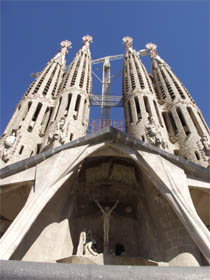
The Sagrada Familia Cathedral in Barcelona will soon serve the church
 |
In 1881, the clergy of the Association of the Followers of Saint Joseph, founded 15 years earlier by librarian Josep Maria Bocabella, purchased land designated for the construction of a cathedral dedicated to the Holy Family (Sagrada Familia). The cornerstone was laid on Saint Joseph's Day, March 19, 1882.
Architect Francesc de Villar submitted the first design, but disputes with the head of the construction committee, Joan Martorell, Bocabella's assistant, led him to leave in 1883. Martorell then suggested his assistant, young Antonio Gaudí, to take his place.
Gaudí presented a completely new project, apart from the crypt that was already built. For the next 43 years, he worked on the construction of the cathedral, which defies all styles and is a very personal interpretation of Art Nouveau. The Catalan architect gained worldwide renown from it.
In the last 15 years of his life, the artist devoted himself entirely to the construction of the temple and did not hesitate to raise money for it on the streets.
However, the unfortunate death of Gaudí, who was hit by a tram in 1926, marked the beginning of a chain of unfortunate events that culminated in the Spanish Civil War in 1936. The crypt was set on fire, and Gaudí's workshop, where plans and models of the cathedral were stored, was destroyed by Francoist troops.
When the crypt was restored, construction of the cathedral resumed in 1940, thanks to architect Francesc Quintana, who reconstructed the models, allowing Gaudí's work to continue even today.
After the facade of the Nativity, he began construction of the Passion facade in 1954, which is now being completed by the Catalan artist Josep Subirachs.
The chairman of the construction committee, Joan Rigol, announced at the beginning of June that the cathedral would be under roof by the end of 2008, allowing for the resumption of liturgy there. The temple will not serve exclusively as a church nor will it be solely a tourist attraction.
There will still be the construction of the Glory facade, whose construction has just begun, as well as the sacristy, baptistery, ciboria, obelisks, and the chapels of Repentance and Assumption.
The cathedral, a symbolic monument of Barcelona, is expected to be completed in 2026, the centenary of Gaudí's death. However, given the progress of the work, it will most likely be completed by 2030.
If the planned deadline had been met, the construction would have taken one and a half centuries, just like the other collective work of the Notre-Dame Cathedral in Paris, which was also worked on without predetermined plans.
Meanwhile, the beatification process for Gaudí began in 2003 in the Vatican. The study of the documentation about the Catalan architect, who according to some documents had mystical abilities, is expected to take several years.
From the very beginning, the construction of the Sagrada Familia temple has been financed by state grants and donations from private companies, which have benefitted significantly from tourism: the cathedral was visited by 2.4 million tourists last year, bringing in 17.6 million euros.
Two months ago, the project for a high-speed train line connecting Barcelona with France sparked criticism and concern, as it is set to run directly beneath the temple. The leadership of the cathedral's construction has already announced that it will oppose the project using all legal means.
The English translation is powered by AI tool. Switch to Czech to view the original text source.
0 comments
add comment












